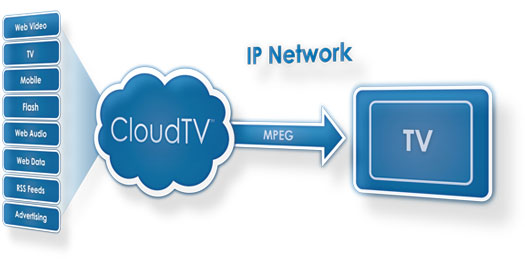


#Cloudtv powered tv#
So our (small) amount of skepticism remains in place, and this paper does little to convince anyone that Cloud TV is faster than conventional cable or IPTV. As long as you don’t have any extra round trips or come across a processor that does not have the power, the two paths are more or less the same. After all this is the same managed network that provides the content in the first place. In effect ActiveVideo has taken the worse-case scenarios for the outcomes that it does not like and the best case scenarios for the Cloud TV outcomes, when the truth lies somewhere between the two in both cases.Įveryone knows intuitively that latency is worse if you are using services which are further away ‘ in the cloud, even if they are in a managed network. When examining the set top approach ActiveVideo adds a lot of time for the event input, because some remote controls can take 80 ms, it does the same for filling a larger buffer and for rendering by saying that some DVRs write it all to disk before they show it on the screen. Everything else is similar to the set top set up. The largest times are 33 ms for both the time for a video frame to transit to the TV and the same time for this to run into a buffer. It suggests the following timings but talks about ‘optimal round trips’:ĪctiveVideo claims that in Cloud TV client processing is minimal, that user input is also minimal, and talks about the CloudTV Stitcher (software running in the network to process a user event), being just 17 ms. It seems to stretch credibility, and the devil, as usual, is in the detail. What the 8 page paper says is that cloud TV is actually inherently faster and it does this by adding up the stages that each approach has to go through, and concludes that a well-tuned Cloud UI can be delivered in roughly 127 milliseconds, compared to between 144 and 430 ms when using a set top. But catching up with the TiVo UI has been the target, more or less, of all recent DVR introductions and UI Cloud introductions.īut the question that most people put up against using Cloud TV is latency, and that’s the next piece of skepticism that cloud players have to address. TiVo has had huge success in introducing its UI to people and that UI has really not been refreshed very much since it first came to light, and once you deploy devices that can use it, there is no TCO advantage when you shift to a slightly better one. Our argument was that it is great to add a new UI whenever you want, but TV can really only go through one paradigm shift per generation, it doesn’t need a new paradigm every five minutes ‘ Faultline has bet that the eventual outcome is a ‘free for all’ shift to tablets from many quarters, with many types of UI, while ActiveVideo believes that the pay TV operator will have control and dominant say over the devices, and they need a common UI across most devices ‘ this is not an opposite position to us at all, just slightly at odds.īut for the most part each operator has to decide on how it introduces HTML 5.0 based devices, and the cloud is one way of doing this early and without a set top refresh and playing with it, and being able to re-invent it until it works. That doesn’t mean that there isn’t something in what the cloud players are saying.
#Cloudtv powered free#
We don’t think that operators will be any better at getting their head around the idea of a set top free world, than many of the support players in the eco-system that we have spoken to. The comparison was unfair, but it had some fangs to it.
#Cloudtv powered upgrade#
It compares an upgrade using the Cloud with no new set top at all, to one that has a completely new, top of the range set top. We denounced that paper as having an element of fakery about it because it assumes that you use the existing set top to do the very little work that a new thin client requires. That paper was written by ACG research, but paid for, and with the core logic coming from, ActiveVideo. It still has a long way to go even after this attempt, written by the company itself, rather than a hired analyst team.īack in July it tried to plant the idea in a very different white paper that operators can save 80% of their capex when implementing a new UI for their TV system if they use ActiveVideo instead of building out a new set top base. If some form of Cloud delivered video, and in particular the ActiveVideo Cloud TV variant, which focuses on rendering video in the cloud, actually works and substantially reduces costs to operators, then there will be masses of disruption.īut right now there is a lot of skepticism, and that’s just what the white papers produced by ActiveVideo are aimed at dispelling. At Faultline we are not so much fans of ActiveVideo as keenly interested to see how much disruption, one well-funded company, can introduce into the entire pay TV equation.


 0 kommentar(er)
0 kommentar(er)
